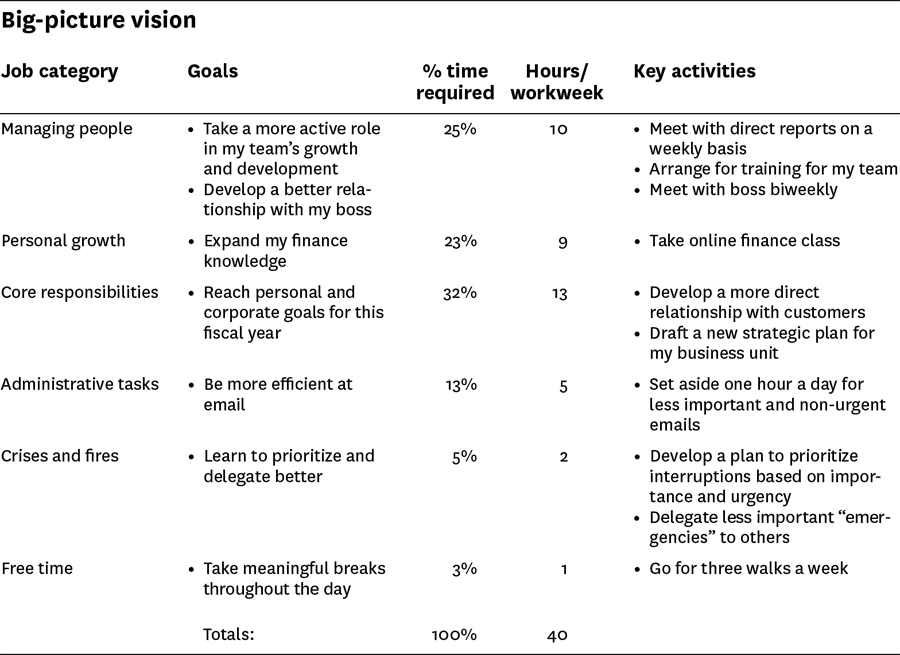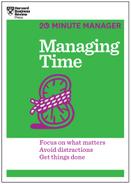Develop a Plan
In the next stage—the planning stage—you’ll take what you learned from time tracking and develop the plan you need to spend your time more wisely in the future.
Reclaim your time
You now have a good idea of which kinds of work are taking the most and the least of your time, and a general sense of how those realities measure up against the goals you’ve set. The next step is to find more time to spend on your highest-priority activity.
Say your goal is to improve your people management, but your time-tracking metrics reveal you’ve been spending only an hour per week on people-management-related tasks—not nearly enough. To meet your goal, you’ll need to devote more time, energy, and resources to it. But how much? Three hours? Five?
Start by thinking about what tasks you’ll need to perform in order to reach your goal. You will probably want to interact more often with your eight direct reports. One way to do this is to schedule weekly, half-hour check-ins with each of them, for a total of four hours. You may also want to think more seriously about planning some training for them—that will probably take another half hour per week.
Next, figure out where you’ll get those extra three and a half hours. Chances are that you don’t have that much free time available, so you’ll have to spend less time doing other things. Identifying where to cut can be tricky—you’ll want to make the right trade-offs. Even though your overall objective is to spend more time on your most important activities, you may not have that many low-value tasks to jettison. Of course you can free up some time by cleaning up some of the bad habits, inefficiencies, and time sinks that you uncovered when tracking your time—such as those thirty minutes you use to unwind after meetings. But some decisions may be more difficult, requiring you to compromise, or revisit, your goals if you can’t “find” enough time.
Most likely, it’s going to take some work to figure out. But take your best guess. You can lock in a more realistic number when you take a closer look at the rest of your job categories, which we’ll cover next.
Create a big-picture vision
The next step is to apply this process of reallocating time more broadly to your other job categories—which will require some prioritizing of your tasks. You’ll also put some interim goals in place to ensure your success. This may seem like overkill, especially if redistributing your time to your highest-priority activity was a straightforward process, but it’s worth the effort because it’s rare that your top priority category is the only one you need to attend to.
Here’s how to do it:
• Prioritize. First, rank all of your time-tracked categories in order of priority (by how important they are—not the amount of time you’re currently spending on them) and place them in the far left column—highest on top, lowest on bottom as shown in table 2.
• Allocate time. Now determine how much time you can spend on each category. You’ve already done this for your highest-priority category. Moving down the list, allocate time to your other categories as well. Of course, you only have so many hours in your week. If you add a few hours to one category, you’ll need to take them away from another. If you’re very busy, you may only be able to adjust your time allotments by a few hours or so. Even that will help.
TABLE 2

This step may take you a few rounds to get right. As you review your list, you may realize that you’ll need to devote more time to some categories than you’d anticipated. In that case, lower your time allocations in one or more other categories to make up the difference. If you’re lucky, you may discover that you can devote less time to something. Then simply allocate the extra time to one of your highest-priority categories.
Note also that your highest priorities, no matter how important they are, will probably take up only a small fraction of your schedule. That’s OK. The objective isn’t to spend the majority of your time on these tasks; it’s to find enough time to ensure that you reach your goals.
Finally, give yourself some breathing room as you build out your schedule; you may want to save a few hours each week to deal with unanticipated activities, such as lunch with a former colleague who’s in town.
• Establish interim goals. Once you have reallocated your time, it’s useful to set goals—interim milestones—in each of your job categories. What do you need to accomplish in a month, quarter, or year? Make sure that these goals match up with any that your manager has made for you, as you did when considering your overall goals at the beginning of this process.
Save your most ambitious goals for your high-priority categories since you’ll want to devote the bulk of your time, focus, and energy to them. It’s still useful to set goals for your other categories as well, however. They’ll keep you focused and motivated.
• Identify key tasks. List the tasks that you’ll need to complete in order to achieve those goals and place them in the next column. If you know the specific steps that you plan on taking, you’re more likely to meet your goals; having more actionable tasks will make it easier to hold yourself accountable. You either complete them or you don’t: There’s no fudging it.
Table 2 is an example of what a big-picture vision should look like. Your job categories, time allocations, goals, and key tasks will probably differ from the ones shown here, but if you follow the basic steps described above, you’ll have no trouble mapping out a realistic and attainable plan of your own.
Do a reality check
Your goals and time allotments may seem reasonable on paper, but once you get into the flow of a workweek, you may find that they’re unrealistic. Perhaps you failed to account for just how much time you spend on a particular task, or how long it takes you to transition between activities, or maybe you even forgot about a category that doesn’t come up very frequently, such as a quarterly report, or annual performance evaluations. The next chapter will show you how to put your plan into action, but as you do so it will be important for you to closely track your progress—by continuing to track your time—for a week or two.
Depending on what you discover, you may need to tweak your time allotments, adjust your goals, or both. Don’t worry: That’s par for the course. Just start at the bottom of your list—with your low-value tasks—and see if you can scale down your goals.
You can’t do everything, so don’t spread yourself too thin. The purpose of time management, isn’t to find ways to do more work; it’s to get the right work done while working at a consistent and comfortable pace. The more realistic, reasonable, and attainable your plan is, the more successful you’ll be at managing your time.
